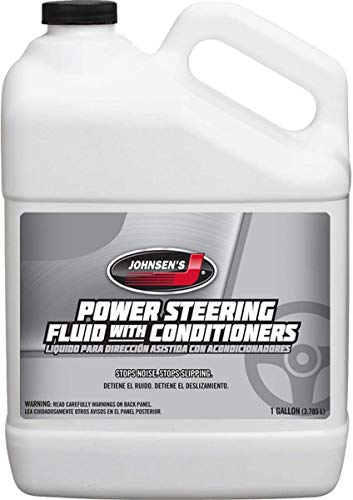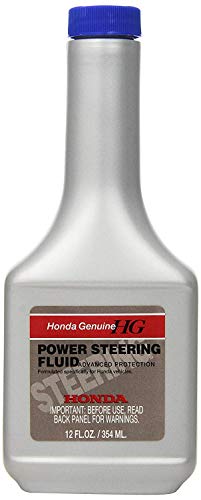Is your steering feeling heavy or unresponsive? It might be time to check your power steering fluid.
Replacing this fluid is a simple yet crucial task that can improve your vehicle’s performance and extend its lifespan. In this guide, you’ll learn how to easily replace power steering fluid, saving you time and money. You’ll gain the confidence to tackle this maintenance task yourself, ensuring your ride remains smooth and safe.
Stick around, and let’s get your steering back in top shape!
Why Power Steering Fluid Matters
Power steering fluid is essential for safe driving. It helps control the steering system. Without it, steering becomes difficult. This can lead to accidents.
Power steering fluid lubricates the components. It reduces wear and tear. This keeps your steering system working smoothly. Regular checks can prevent bigger problems.
Dirty or low fluid can cause noise. It might also make steering less responsive. These signs indicate a need for replacement. Keeping the fluid clean ensures better performance.
Proper fluid levels help maintain control. This is especially important in tight turns. You need a reliable steering system for safety.
Overall, maintaining power steering fluid is crucial. It affects the car’s handling and safety. Regular checks can save you from costly repairs.
Signs It’s Time To Replace Fluid
Power steering fluid is vital for smooth steering. Signs it needs replacing include strange noises, stiff steering, or fluid leaks. Replacing it is simple. Just drain the old fluid and add new fluid. Regular checks can help maintain your vehicle’s performance.
Recognizing the signs that it’s time to replace your power steering fluid can save you from bigger issues down the road. Your vehicle communicates with you through various indicators. Staying attentive to these signs can keep your steering smooth and your driving experience safe.Strange Noises While Turning
Hearing strange noises while turning the steering wheel is a clear red flag. A whining, groaning, or squealing sound often indicates that your power steering fluid is low or dirty. This noise can be a warning that your power steering pump is straining to work properly. Have you ever been in a situation where you turned your wheel and heard an unsettling sound? It can be alarming. Ignoring these noises might lead to more serious damage, so pay attention!Difficulty Steering
If you find it hard to steer, it’s time to check your power steering fluid. Difficulty in turning the wheel, especially at low speeds, can signal that the fluid is low or contaminated. This can make driving feel laborious and uncomfortable. Have you struggled to make a simple turn in a parking lot? That’s not just inconvenient; it’s a warning sign. Your safety is paramount, so don’t brush off this issue.Dark Or Dirty Fluid
Inspecting your power steering fluid regularly can reveal a lot about its condition. Healthy fluid should be a clear, bright red color. If it appears dark or dirty, it’s time to replace it. Checking the fluid might be something you overlook, but it’s a simple task. Use a clean cloth to wipe the dipstick and see the true color of your fluid. If it doesn’t look right, take action before it affects your steering system. Being proactive about these signs can enhance your driving experience and ensure your vehicle operates smoothly. Don’t wait for a minor issue to escalate into a major problem. Keep your power steering fluid in check and enjoy the ride!Tools And Materials Needed
Replacing power steering fluid is simple. Gather the right tools and materials first. This will make the job easier and faster. Here’s what you need.
Power Steering Fluid
Choose the right power steering fluid for your vehicle. Check the owner’s manual for the correct type. Using the wrong fluid can damage your system.
Turkey Baster Or Fluid Extractor
A turkey baster or fluid extractor helps remove old fluid. A baster is cheap and easy to use. A fluid extractor can hold more fluid and is quicker.
Drain Pan
A drain pan is essential for catching old fluid. Place it under the steering fluid reservoir. This keeps your workspace clean and safe.
Funnel
A funnel makes pouring new fluid easier. It prevents spills and messes. Choose a funnel with a narrow spout for better control.
Gloves And Rags
Wear gloves to protect your hands from fluid. Rags help clean up any spills. Stay neat and safe during the process.
Preparing Your Vehicle
Power steering fluid is essential for smooth driving. Replacing it keeps your steering system in good shape. Follow easy steps to drain the old fluid and add new fluid for better performance. Regular checks can prevent bigger issues down the road.
Preparing your vehicle for a power steering fluid change is a crucial step to ensure the process goes smoothly. Taking the right precautions can save you time and hassle later on. Let’s break down the key steps you need to follow.Locate The Power Steering Reservoir
The first step is to find the power steering reservoir. This is usually a clear or translucent container located near the engine. Look for a cap labeled “Power Steering” or a steering wheel icon. Check your owner’s manual if you’re unsure where it is. Familiarizing yourself with this part of your vehicle can make the entire process easier.Park On A Level Surface
Next, make sure your vehicle is parked on a level surface. This helps in getting an accurate reading of your current fluid level. If your car is on an incline, the fluid may shift, leading to incorrect measurements. Always engage the parking brake to ensure safety while you work. You don’t want your vehicle rolling away when you’re focused on the task at hand.Turn Off The Engine
Before you begin, turn off the engine. This is essential for your safety and allows the fluid to settle. You might be tempted to leave the engine running for better access, but that’s risky. Taking these moments to double-check your tools can save you from scrambling later. Make sure you have a funnel, a clean container for the old fluid, and the new power steering fluid ready. Have you ever made a last-minute trip to the store for a missing item? Avoid that hassle by preparing in advance!Draining The Old Fluid
Draining the old power steering fluid is an important step. Fresh fluid helps your steering system work better. Old fluid can contain dirt and debris. This can affect performance. Follow these steps to drain the fluid safely and effectively.
Siphon Fluid From Reservoir
Start by locating the power steering fluid reservoir. It is usually near the engine. Use a siphon pump or turkey baster. Insert it into the reservoir. Squeeze the bulb to suck out the old fluid. Make sure to remove as much fluid as possible. Check the color and clarity of the fluid. Dark, murky fluid means it needs to be replaced.
Dispose Of Fluid Safely
Do not throw old fluid in the trash. It can harm the environment. Check local regulations for disposal options. Many places have recycling centers for used fluids. Place the old fluid in a sealed container. Label it clearly to avoid confusion. Take it to a recycling center or a hazardous waste facility.
Flushing The Power Steering System
Flushing the power steering system keeps it clean. This process removes old fluid and debris. Fresh fluid helps the system work better. It also prevents damage to the components.
Flushing requires a few steps. You will need some tools and new fluid. Follow these steps carefully for the best results.
Disconnect The Return Line
Start by locating the return line. This line connects the power steering pump to the reservoir. Use a wrench to loosen the fitting. Be careful not to damage the line.
Once loose, place a container under the line. This will catch the old fluid. Carefully remove the return line and let the fluid drain.
Cycle New Fluid Through System
Next, reconnect the return line. Make sure it is secure. Now pour new power steering fluid into the reservoir.
Start the engine and turn the wheel. This will help push the new fluid through the system. Keep an eye on the fluid level. Add more fluid as needed.
Repeat Until Fluid Runs Clear
Continue this process. Repeat cycling the new fluid. Check the fluid color in the container. It should change from dark to clear.
Once the fluid runs clear, you are done. Turn off the engine and check the fluid level one last time.
Adding New Fluid
Replacing power steering fluid is an important maintenance task. Start by locating the reservoir and checking the fluid level. After that, add the new fluid slowly until it reaches the recommended level. This helps keep your steering system working smoothly.
Adding new power steering fluid is a straightforward yet crucial step in maintaining your vehicle’s steering system. Over time, the fluid can become contaminated or low, leading to steering issues. Keeping the fluid at the right level ensures smooth handling and prolongs the life of your power steering system.Pour Fluid Into Reservoir
Start by locating the power steering fluid reservoir. It’s typically marked with a symbol that looks like a steering wheel. Carefully remove the cap and check for any debris inside. Next, take your new power steering fluid and slowly pour it into the reservoir. Make sure you use the type of fluid recommended in your owner’s manual. Don’t rush this process; adding fluid too quickly can lead to spills.Use The Funnel To Avoid Spills
A funnel is your best friend during this task. It helps direct the fluid into the reservoir without creating a mess. Position the funnel securely in the opening. As you pour, keep an eye on the fluid level to prevent overfilling. If you do spill, clean it immediately to avoid any damage to your car’s paint or components. Have you ever faced a situation where a simple spill turned into a bigger problem? A funnel can save you from that headache.Check For Proper Fluid Level
After adding the fluid, it’s essential to check the level. Most reservoirs have markings indicating the proper fluid level. If the fluid is too low, you may need to add more. If it’s over the maximum mark, use a turkey baster or similar tool to remove the excess fluid. Regularly checking your fluid level can prevent steering issues down the road. Have you made it a habit to check your fluids? It’s a small step that can make a big difference in your vehicle’s performance. Taking these steps ensures that your power steering system operates smoothly and efficiently.Checking For Leaks
Checking for leaks is an important step in replacing power steering fluid. Leaks can cause low fluid levels. Low levels may damage your steering system. Finding leaks early saves time and money.
Inspect Hoses And Connections
Start by inspecting hoses and connections. Look for cracks or worn areas. Any signs of fluid on the ground indicate a problem. Check the clamps that hold the hoses. Loose clamps can cause leaks. Tighten them if needed.
Feel the hoses. If they feel soft or spongy, they may need replacement. Look closely at all connections. This includes the reservoir and steering gear. A small leak can lead to bigger issues.
Test Drive The Vehicle
After checking for leaks, take a test drive. Drive slowly and listen for any unusual noises. Pay attention to how the steering feels. If it feels loose or unresponsive, stop and check again.
Look under the vehicle after the drive. Check for any new fluid spots. Any change might indicate a leak. Testing helps confirm that everything is working well.
Maintaining Your Power Steering System
Keeping your power steering system in good shape is essential. Proper maintenance helps ensure smooth steering. It also extends the life of your vehicle. Regular checks can prevent bigger issues down the road.
Monitor Fluid Levels Regularly
Check your power steering fluid levels often. Low fluid can lead to steering problems. Open the hood and locate the reservoir. Use the dipstick or markings on the side to check levels.
Fill the reservoir if the fluid is low. Use the correct type of fluid for your vehicle. Avoid mixing different types of fluid. This can cause damage to the system.
Check For Unusual Noises
Listen for strange sounds when turning the wheel. Squealing or whining noises may indicate issues. These sounds can mean low fluid or a failing pump. Address these sounds quickly to avoid bigger problems.
Take note of any changes in noise. The earlier you notice, the better. Ignoring these signs can lead to costly repairs.
Schedule Routine Inspections
Regular inspections are key for your power steering system. Have a mechanic check the system at least once a year. They can spot potential issues early.
An inspection includes checking fluid levels, hoses, and the pump. Keeping everything in good condition helps prevent failures. Stay proactive to keep your steering smooth and safe.
Frequently Asked Questions
Can I Replace Power Steering Fluid On My Own?
Yes, you can replace power steering fluid on your own. Gather the necessary tools and follow the vehicle’s manual. Ensure you use the correct type of fluid for your car. Properly dispose of the old fluid. Regular maintenance helps keep your steering system in good condition.
Can I Just Refill My Power Steering Fluid?
Refilling power steering fluid is possible, but check for leaks first. Low fluid levels may indicate a problem. Regular maintenance ensures optimal performance. Always use the recommended fluid type for your vehicle. If issues persist, consult a mechanic for further diagnosis and repairs.
Can I Mix Old Power Steering Fluid With New?
Mixing old power steering fluid with new is not recommended. Different formulations can cause issues like foaming or reduced performance. Always flush the system and use the same type of fluid for best results. Regular maintenance ensures optimal steering performance and prolongs system life.
Is A Power Steering Fluid Flush Really Necessary?
A power steering fluid flush is not always necessary. Regular maintenance helps prevent buildup and ensures optimal performance. Check your vehicle’s manual for recommendations. Signs of problems include noise or difficulty steering. Flushing can improve responsiveness and extend the system’s lifespan.
Always consult a professional for specific advice.
Conclusion
Replacing power steering fluid is a simple task. Regular maintenance helps your vehicle run smoothly. It improves steering response and extends the life of your system. Follow the steps carefully for best results. Always check the fluid level often. Clean any spills to avoid damage.
With practice, this task becomes easier. Keeping your power steering fluid fresh is important. Your car will thank you with better performance. Take charge of your car’s care today.

Benjamin Grey is an automotive engineer and writer at Car Parts Advisor. With years of experience in the automotive industry, he shares expert advice on car parts, maintenance, and repairs to help car owners keep their vehicles running smoothly.



